UGB 163 Introduction to Accounting & Finance: Company Analysis
VerifiedAdded on 2022/11/29
|17
|3767
|152
Report
AI Summary
This report provides a comprehensive analysis of accounting and finance principles through the examination of three companies: Racca Limited, Stockstone Limited, and Rockham Plc. For Racca Limited, the report includes an income statement and balance sheet, revealing the company's financial performance and position. Stockstone Limited's analysis covers contribution margin, break-even point, margin of safety, and profitability under different scenarios, along with a strategic recommendation. The report also identifies the underlying assumptions of the break-even model. For Rockham Plc, the analysis focuses on investment appraisal techniques, including payback period, net present value (NPV), and accounting rate of return (ARR), offering a recommendation based on these metrics. The merits and limitations of these investment appraisal techniques are discussed, as well as the benefits and limitations of using budgets for strategic planning. The report concludes with an overall assessment of the financial health and investment potential of the companies analyzed.
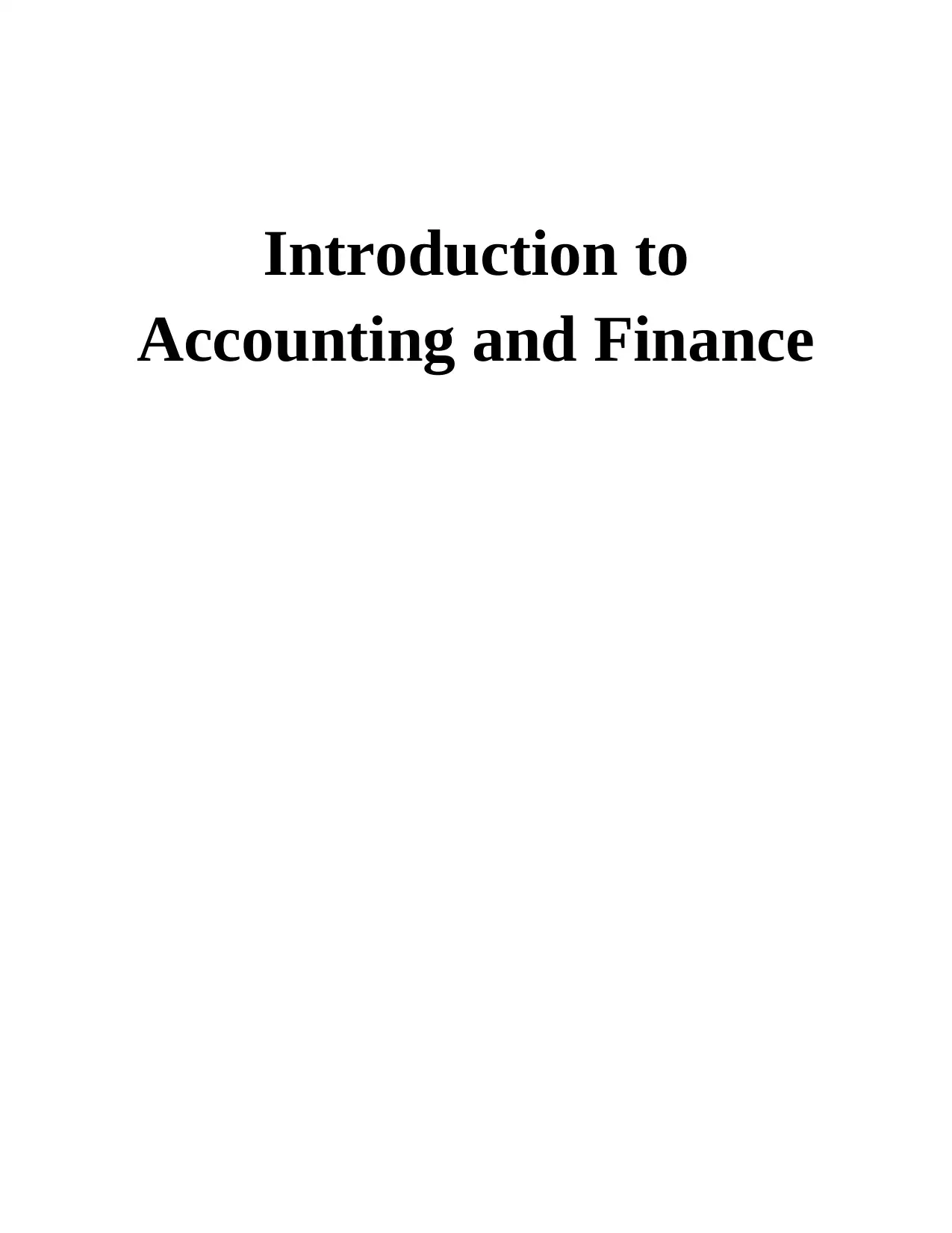
Introduction to
Accounting and Finance
Accounting and Finance
Paraphrase This Document
Need a fresh take? Get an instant paraphrase of this document with our AI Paraphraser

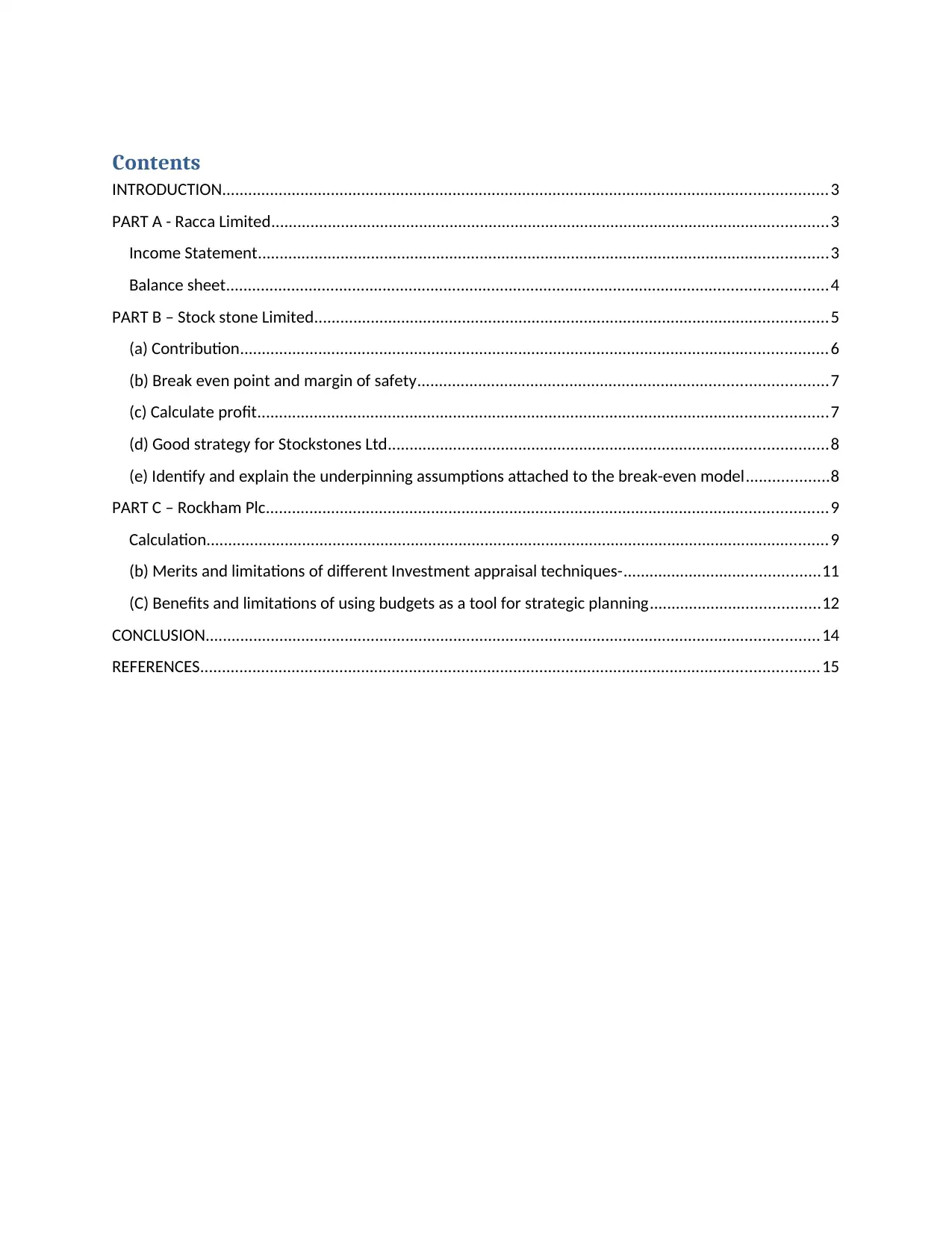
Contents
INTRODUCTION...........................................................................................................................................3
PART A - Racca Limited................................................................................................................................3
Income Statement...................................................................................................................................3
Balance sheet..........................................................................................................................................4
PART B – Stock stone Limited......................................................................................................................5
(a) Contribution.......................................................................................................................................6
(b) Break even point and margin of safety..............................................................................................7
(c) Calculate profit...................................................................................................................................7
(d) Good strategy for Stockstones Ltd.....................................................................................................8
(e) Identify and explain the underpinning assumptions attached to the break-even model...................8
PART C – Rockham Plc.................................................................................................................................9
Calculation...............................................................................................................................................9
(b) Merits and limitations of different Investment appraisal techniques-.............................................11
(C) Benefits and limitations of using budgets as a tool for strategic planning.......................................12
CONCLUSION.............................................................................................................................................14
REFERENCES..............................................................................................................................................15
INTRODUCTION...........................................................................................................................................3
PART A - Racca Limited................................................................................................................................3
Income Statement...................................................................................................................................3
Balance sheet..........................................................................................................................................4
PART B – Stock stone Limited......................................................................................................................5
(a) Contribution.......................................................................................................................................6
(b) Break even point and margin of safety..............................................................................................7
(c) Calculate profit...................................................................................................................................7
(d) Good strategy for Stockstones Ltd.....................................................................................................8
(e) Identify and explain the underpinning assumptions attached to the break-even model...................8
PART C – Rockham Plc.................................................................................................................................9
Calculation...............................................................................................................................................9
(b) Merits and limitations of different Investment appraisal techniques-.............................................11
(C) Benefits and limitations of using budgets as a tool for strategic planning.......................................12
CONCLUSION.............................................................................................................................................14
REFERENCES..............................................................................................................................................15
⊘ This is a preview!⊘
Do you want full access?
Subscribe today to unlock all pages.

Trusted by 1+ million students worldwide
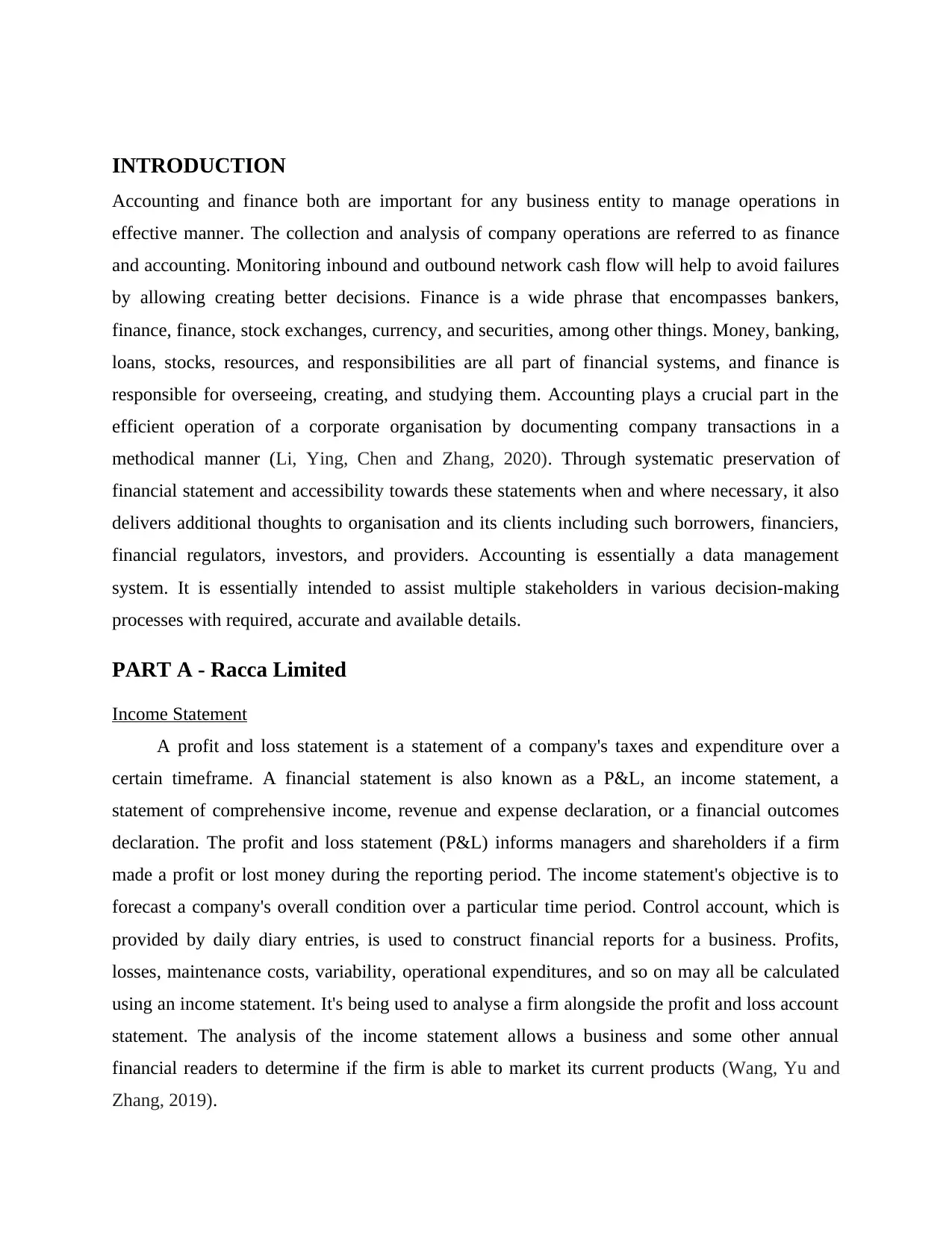
INTRODUCTION
Accounting and finance both are important for any business entity to manage operations in
effective manner. The collection and analysis of company operations are referred to as finance
and accounting. Monitoring inbound and outbound network cash flow will help to avoid failures
by allowing creating better decisions. Finance is a wide phrase that encompasses bankers,
finance, finance, stock exchanges, currency, and securities, among other things. Money, banking,
loans, stocks, resources, and responsibilities are all part of financial systems, and finance is
responsible for overseeing, creating, and studying them. Accounting plays a crucial part in the
efficient operation of a corporate organisation by documenting company transactions in a
methodical manner (Li, Ying, Chen and Zhang, 2020). Through systematic preservation of
financial statement and accessibility towards these statements when and where necessary, it also
delivers additional thoughts to organisation and its clients including such borrowers, financiers,
financial regulators, investors, and providers. Accounting is essentially a data management
system. It is essentially intended to assist multiple stakeholders in various decision-making
processes with required, accurate and available details.
PART A - Racca Limited
Income Statement
A profit and loss statement is a statement of a company's taxes and expenditure over a
certain timeframe. A financial statement is also known as a P&L, an income statement, a
statement of comprehensive income, revenue and expense declaration, or a financial outcomes
declaration. The profit and loss statement (P&L) informs managers and shareholders if a firm
made a profit or lost money during the reporting period. The income statement's objective is to
forecast a company's overall condition over a particular time period. Control account, which is
provided by daily diary entries, is used to construct financial reports for a business. Profits,
losses, maintenance costs, variability, operational expenditures, and so on may all be calculated
using an income statement. It's being used to analyse a firm alongside the profit and loss account
statement. The analysis of the income statement allows a business and some other annual
financial readers to determine if the firm is able to market its current products (Wang, Yu and
Zhang, 2019).
Accounting and finance both are important for any business entity to manage operations in
effective manner. The collection and analysis of company operations are referred to as finance
and accounting. Monitoring inbound and outbound network cash flow will help to avoid failures
by allowing creating better decisions. Finance is a wide phrase that encompasses bankers,
finance, finance, stock exchanges, currency, and securities, among other things. Money, banking,
loans, stocks, resources, and responsibilities are all part of financial systems, and finance is
responsible for overseeing, creating, and studying them. Accounting plays a crucial part in the
efficient operation of a corporate organisation by documenting company transactions in a
methodical manner (Li, Ying, Chen and Zhang, 2020). Through systematic preservation of
financial statement and accessibility towards these statements when and where necessary, it also
delivers additional thoughts to organisation and its clients including such borrowers, financiers,
financial regulators, investors, and providers. Accounting is essentially a data management
system. It is essentially intended to assist multiple stakeholders in various decision-making
processes with required, accurate and available details.
PART A - Racca Limited
Income Statement
A profit and loss statement is a statement of a company's taxes and expenditure over a
certain timeframe. A financial statement is also known as a P&L, an income statement, a
statement of comprehensive income, revenue and expense declaration, or a financial outcomes
declaration. The profit and loss statement (P&L) informs managers and shareholders if a firm
made a profit or lost money during the reporting period. The income statement's objective is to
forecast a company's overall condition over a particular time period. Control account, which is
provided by daily diary entries, is used to construct financial reports for a business. Profits,
losses, maintenance costs, variability, operational expenditures, and so on may all be calculated
using an income statement. It's being used to analyse a firm alongside the profit and loss account
statement. The analysis of the income statement allows a business and some other annual
financial readers to determine if the firm is able to market its current products (Wang, Yu and
Zhang, 2019).
Paraphrase This Document
Need a fresh take? Get an instant paraphrase of this document with our AI Paraphraser
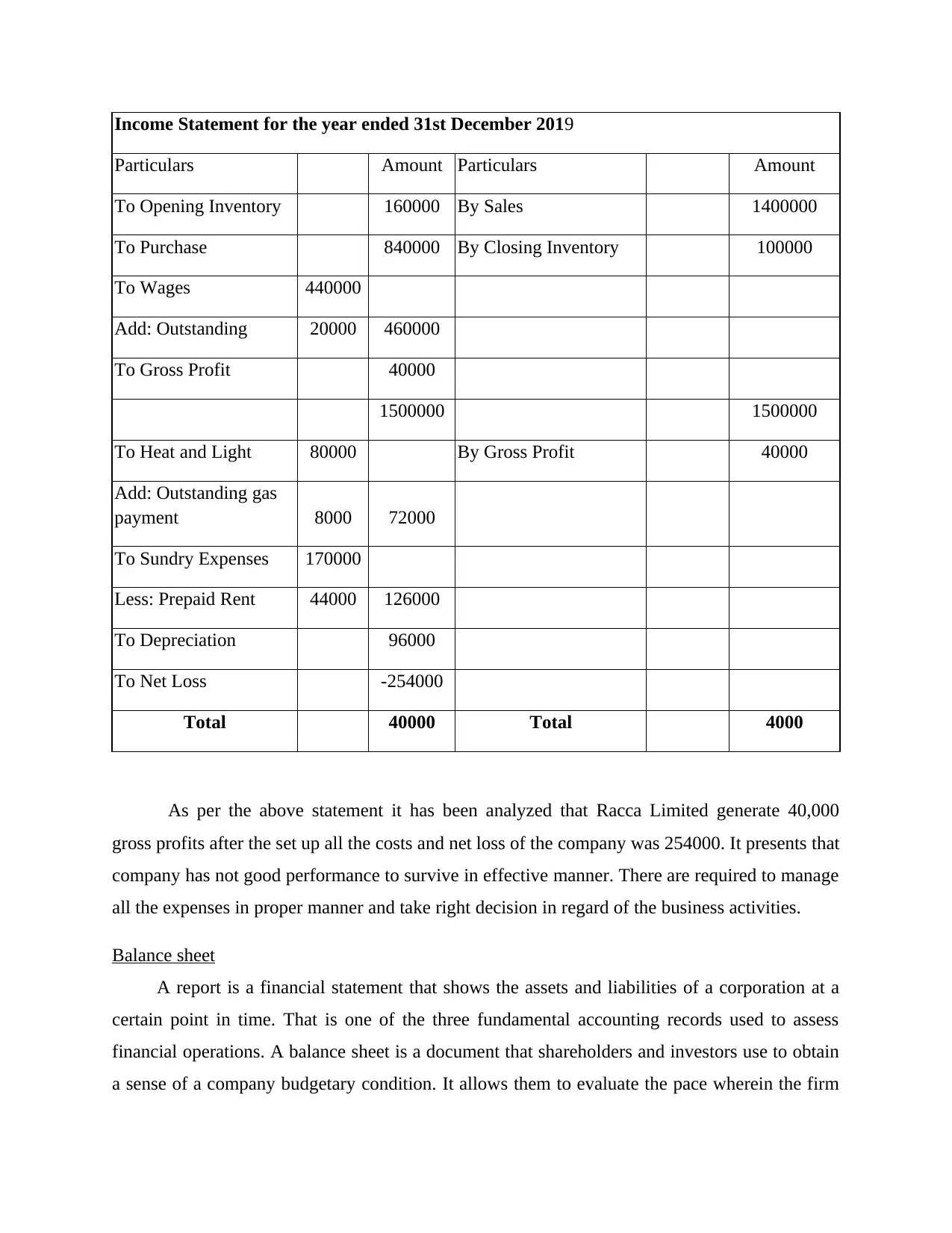
Income Statement for the year ended 31st December 2019
Particulars Amount Particulars Amount
To Opening Inventory 160000 By Sales 1400000
To Purchase 840000 By Closing Inventory 100000
To Wages 440000
Add: Outstanding 20000 460000
To Gross Profit 40000
1500000 1500000
To Heat and Light 80000 By Gross Profit 40000
Add: Outstanding gas
payment 8000 72000
To Sundry Expenses 170000
Less: Prepaid Rent 44000 126000
To Depreciation 96000
To Net Loss -254000
Total 40000 Total 4000
As per the above statement it has been analyzed that Racca Limited generate 40,000
gross profits after the set up all the costs and net loss of the company was 254000. It presents that
company has not good performance to survive in effective manner. There are required to manage
all the expenses in proper manner and take right decision in regard of the business activities.
Balance sheet
A report is a financial statement that shows the assets and liabilities of a corporation at a
certain point in time. That is one of the three fundamental accounting records used to assess
financial operations. A balance sheet is a document that shareholders and investors use to obtain
a sense of a company budgetary condition. It allows them to evaluate the pace wherein the firm
Particulars Amount Particulars Amount
To Opening Inventory 160000 By Sales 1400000
To Purchase 840000 By Closing Inventory 100000
To Wages 440000
Add: Outstanding 20000 460000
To Gross Profit 40000
1500000 1500000
To Heat and Light 80000 By Gross Profit 40000
Add: Outstanding gas
payment 8000 72000
To Sundry Expenses 170000
Less: Prepaid Rent 44000 126000
To Depreciation 96000
To Net Loss -254000
Total 40000 Total 4000
As per the above statement it has been analyzed that Racca Limited generate 40,000
gross profits after the set up all the costs and net loss of the company was 254000. It presents that
company has not good performance to survive in effective manner. There are required to manage
all the expenses in proper manner and take right decision in regard of the business activities.
Balance sheet
A report is a financial statement that shows the assets and liabilities of a corporation at a
certain point in time. That is one of the three fundamental accounting records used to assess
financial operations. A balance sheet is a document that shareholders and investors use to obtain
a sense of a company budgetary condition. It allows them to evaluate the pace wherein the firm
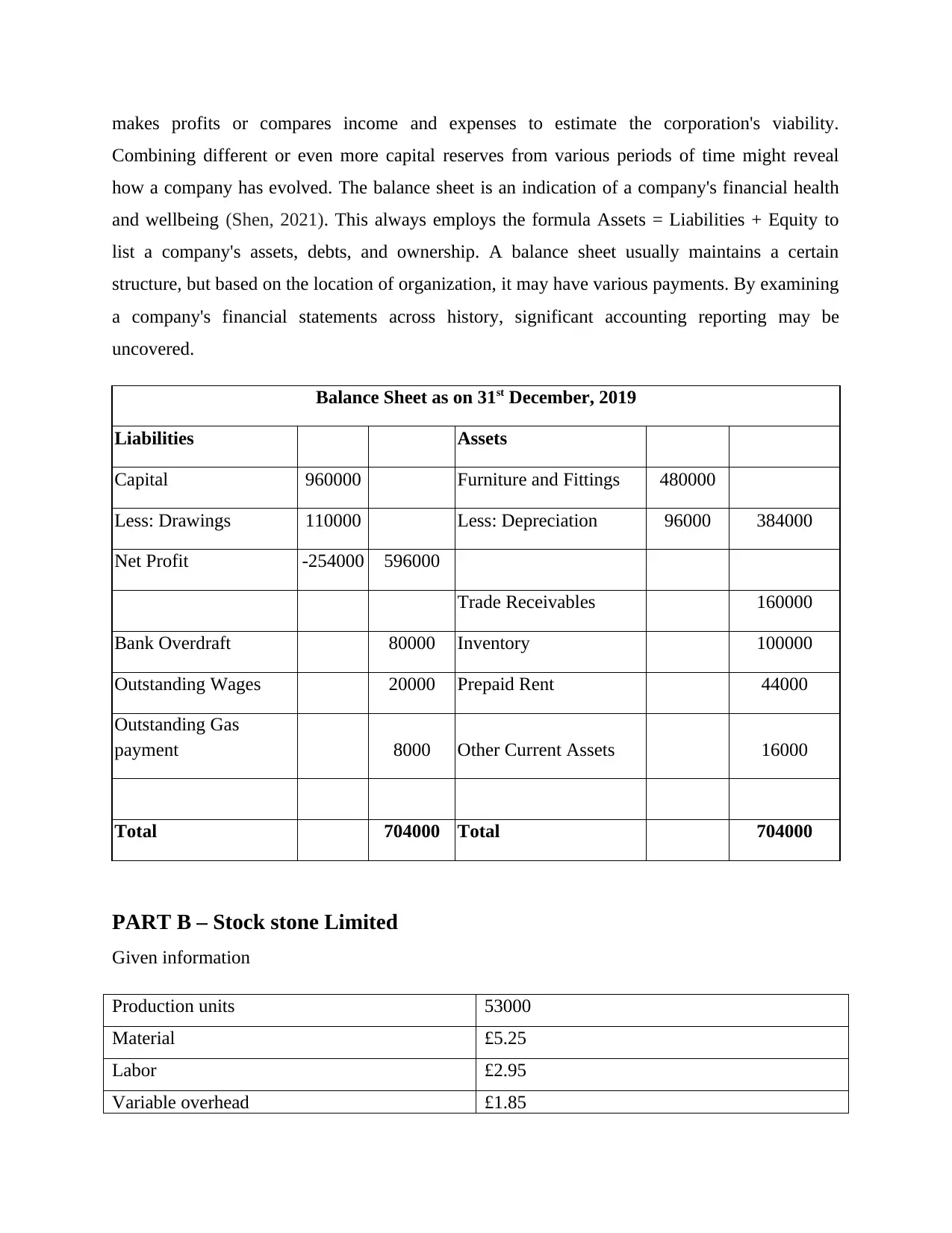
makes profits or compares income and expenses to estimate the corporation's viability.
Combining different or even more capital reserves from various periods of time might reveal
how a company has evolved. The balance sheet is an indication of a company's financial health
and wellbeing (Shen, 2021). This always employs the formula Assets = Liabilities + Equity to
list a company's assets, debts, and ownership. A balance sheet usually maintains a certain
structure, but based on the location of organization, it may have various payments. By examining
a company's financial statements across history, significant accounting reporting may be
uncovered.
Balance Sheet as on 31st December, 2019
Liabilities Assets
Capital 960000 Furniture and Fittings 480000
Less: Drawings 110000 Less: Depreciation 96000 384000
Net Profit -254000 596000
Trade Receivables 160000
Bank Overdraft 80000 Inventory 100000
Outstanding Wages 20000 Prepaid Rent 44000
Outstanding Gas
payment 8000 Other Current Assets 16000
Total 704000 Total 704000
PART B – Stock stone Limited
Given information
Production units 53000
Material £5.25
Labor £2.95
Variable overhead £1.85
Combining different or even more capital reserves from various periods of time might reveal
how a company has evolved. The balance sheet is an indication of a company's financial health
and wellbeing (Shen, 2021). This always employs the formula Assets = Liabilities + Equity to
list a company's assets, debts, and ownership. A balance sheet usually maintains a certain
structure, but based on the location of organization, it may have various payments. By examining
a company's financial statements across history, significant accounting reporting may be
uncovered.
Balance Sheet as on 31st December, 2019
Liabilities Assets
Capital 960000 Furniture and Fittings 480000
Less: Drawings 110000 Less: Depreciation 96000 384000
Net Profit -254000 596000
Trade Receivables 160000
Bank Overdraft 80000 Inventory 100000
Outstanding Wages 20000 Prepaid Rent 44000
Outstanding Gas
payment 8000 Other Current Assets 16000
Total 704000 Total 704000
PART B – Stock stone Limited
Given information
Production units 53000
Material £5.25
Labor £2.95
Variable overhead £1.85
⊘ This is a preview!⊘
Do you want full access?
Subscribe today to unlock all pages.

Trusted by 1+ million students worldwide
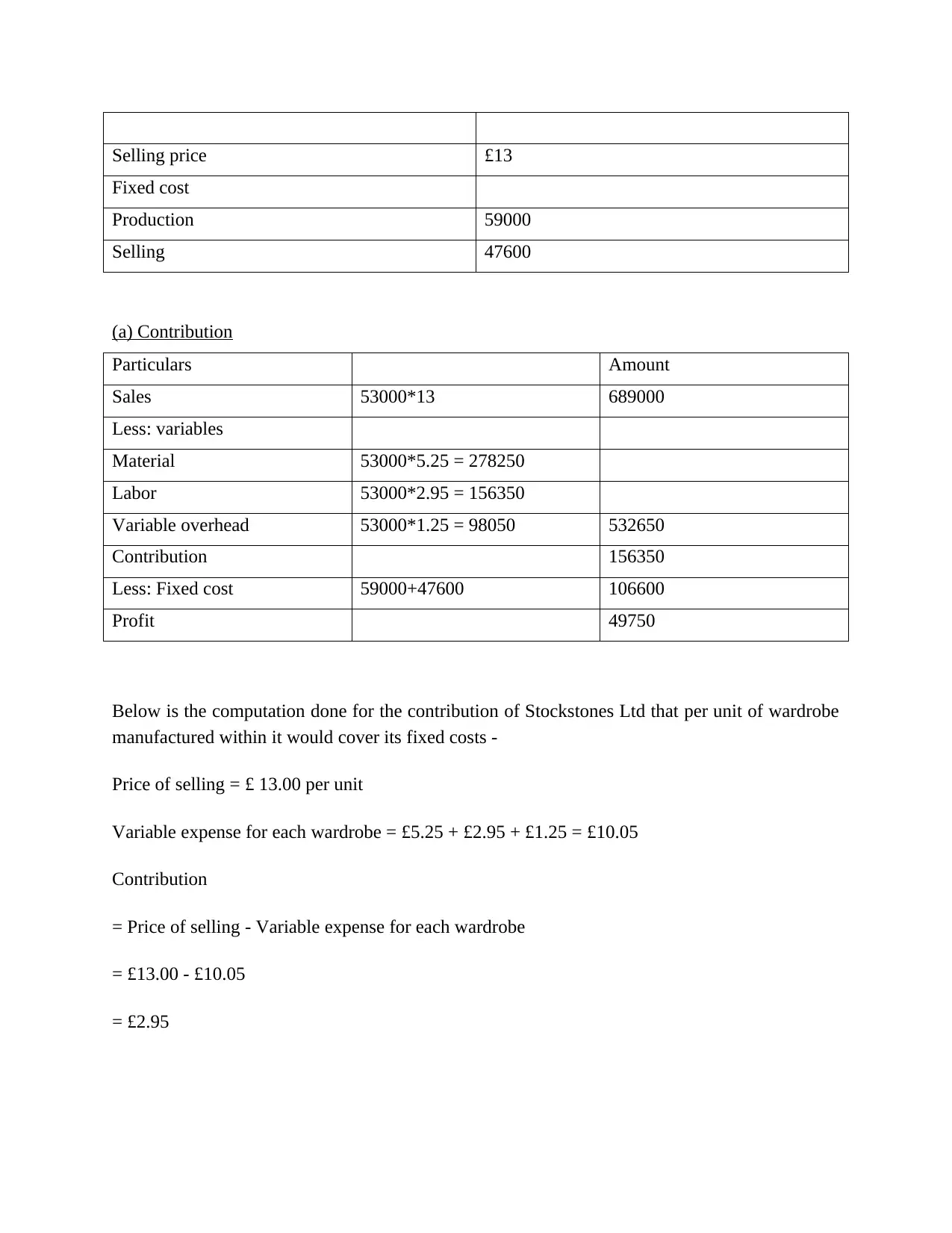
Selling price £13
Fixed cost
Production 59000
Selling 47600
(a) Contribution
Particulars Amount
Sales 53000*13 689000
Less: variables
Material 53000*5.25 = 278250
Labor 53000*2.95 = 156350
Variable overhead 53000*1.25 = 98050 532650
Contribution 156350
Less: Fixed cost 59000+47600 106600
Profit 49750
Below is the computation done for the contribution of Stockstones Ltd that per unit of wardrobe
manufactured within it would cover its fixed costs -
Price of selling = £ 13.00 per unit
Variable expense for each wardrobe = £5.25 + £2.95 + £1.25 = £10.05
Contribution
= Price of selling - Variable expense for each wardrobe
= £13.00 - £10.05
= £2.95
Fixed cost
Production 59000
Selling 47600
(a) Contribution
Particulars Amount
Sales 53000*13 689000
Less: variables
Material 53000*5.25 = 278250
Labor 53000*2.95 = 156350
Variable overhead 53000*1.25 = 98050 532650
Contribution 156350
Less: Fixed cost 59000+47600 106600
Profit 49750
Below is the computation done for the contribution of Stockstones Ltd that per unit of wardrobe
manufactured within it would cover its fixed costs -
Price of selling = £ 13.00 per unit
Variable expense for each wardrobe = £5.25 + £2.95 + £1.25 = £10.05
Contribution
= Price of selling - Variable expense for each wardrobe
= £13.00 - £10.05
= £2.95
Paraphrase This Document
Need a fresh take? Get an instant paraphrase of this document with our AI Paraphraser
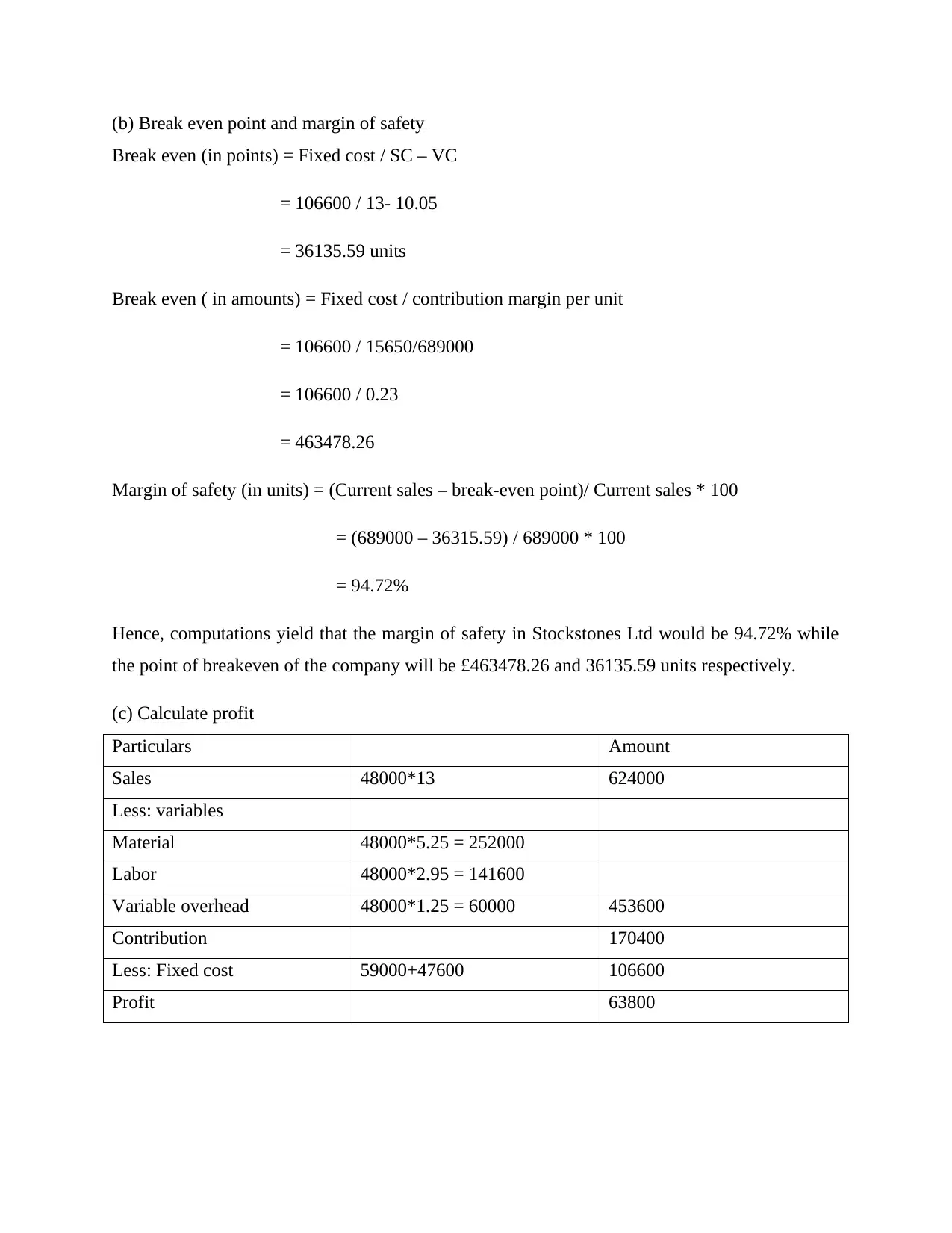
(b) Break even point and margin of safety
Break even (in points) = Fixed cost / SC – VC
= 106600 / 13- 10.05
= 36135.59 units
Break even ( in amounts) = Fixed cost / contribution margin per unit
= 106600 / 15650/689000
= 106600 / 0.23
= 463478.26
Margin of safety (in units) = (Current sales – break-even point)/ Current sales * 100
= (689000 – 36315.59) / 689000 * 100
= 94.72%
Hence, computations yield that the margin of safety in Stockstones Ltd would be 94.72% while
the point of breakeven of the company will be £463478.26 and 36135.59 units respectively.
(c) Calculate profit
Particulars Amount
Sales 48000*13 624000
Less: variables
Material 48000*5.25 = 252000
Labor 48000*2.95 = 141600
Variable overhead 48000*1.25 = 60000 453600
Contribution 170400
Less: Fixed cost 59000+47600 106600
Profit 63800
Break even (in points) = Fixed cost / SC – VC
= 106600 / 13- 10.05
= 36135.59 units
Break even ( in amounts) = Fixed cost / contribution margin per unit
= 106600 / 15650/689000
= 106600 / 0.23
= 463478.26
Margin of safety (in units) = (Current sales – break-even point)/ Current sales * 100
= (689000 – 36315.59) / 689000 * 100
= 94.72%
Hence, computations yield that the margin of safety in Stockstones Ltd would be 94.72% while
the point of breakeven of the company will be £463478.26 and 36135.59 units respectively.
(c) Calculate profit
Particulars Amount
Sales 48000*13 624000
Less: variables
Material 48000*5.25 = 252000
Labor 48000*2.95 = 141600
Variable overhead 48000*1.25 = 60000 453600
Contribution 170400
Less: Fixed cost 59000+47600 106600
Profit 63800
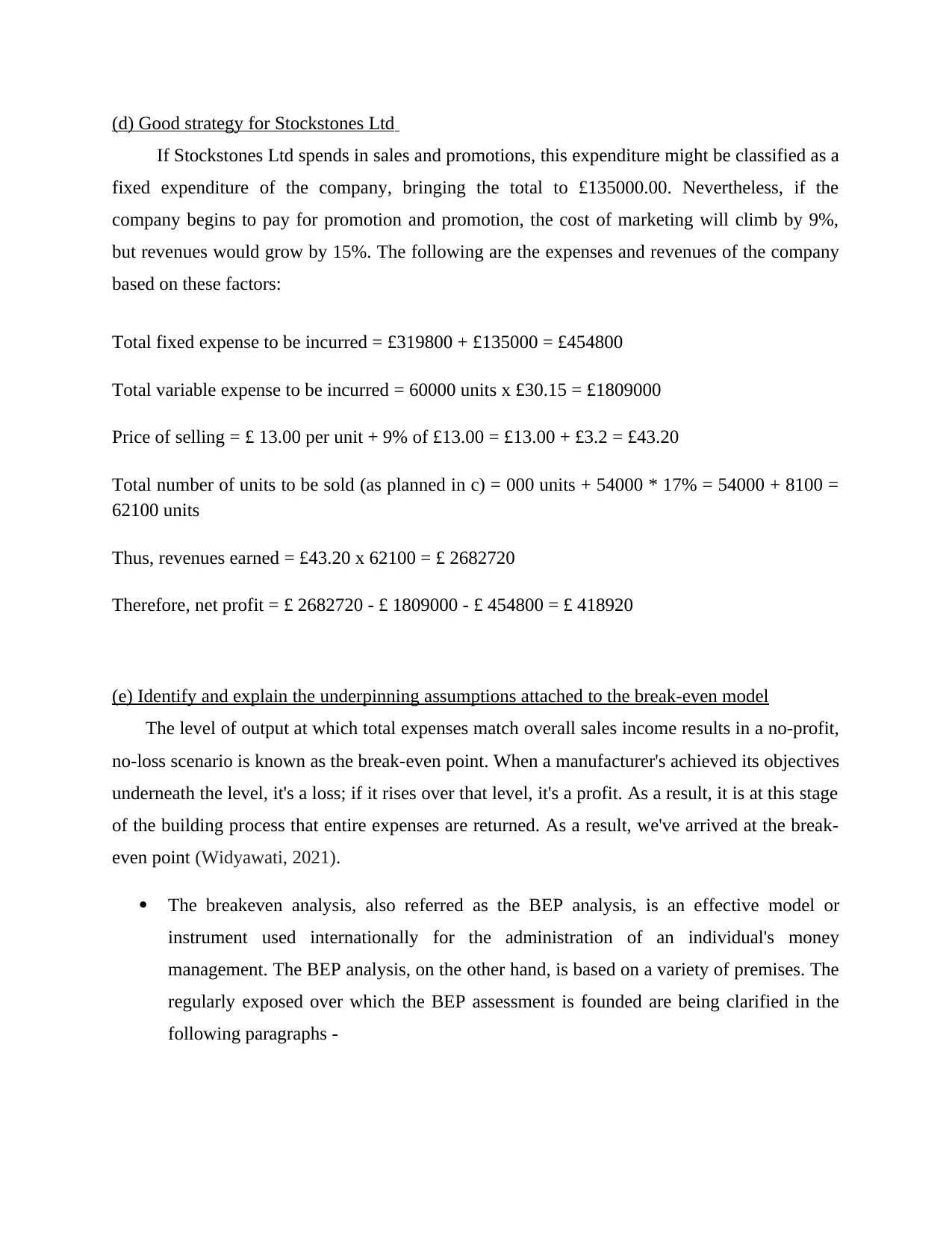
(d) Good strategy for Stockstones Ltd
If Stockstones Ltd spends in sales and promotions, this expenditure might be classified as a
fixed expenditure of the company, bringing the total to £135000.00. Nevertheless, if the
company begins to pay for promotion and promotion, the cost of marketing will climb by 9%,
but revenues would grow by 15%. The following are the expenses and revenues of the company
based on these factors:
Total fixed expense to be incurred = £319800 + £135000 = £454800
Total variable expense to be incurred = 60000 units x £30.15 = £1809000
Price of selling = £ 13.00 per unit + 9% of £13.00 = £13.00 + £3.2 = £43.20
Total number of units to be sold (as planned in c) = 000 units + 54000 * 17% = 54000 + 8100 =
62100 units
Thus, revenues earned = £43.20 x 62100 = £ 2682720
Therefore, net profit = £ 2682720 - £ 1809000 - £ 454800 = £ 418920
(e) Identify and explain the underpinning assumptions attached to the break-even model
The level of output at which total expenses match overall sales income results in a no-profit,
no-loss scenario is known as the break-even point. When a manufacturer's achieved its objectives
underneath the level, it's a loss; if it rises over that level, it's a profit. As a result, it is at this stage
of the building process that entire expenses are returned. As a result, we've arrived at the break-
even point (Widyawati, 2021).
The breakeven analysis, also referred as the BEP analysis, is an effective model or
instrument used internationally for the administration of an individual's money
management. The BEP analysis, on the other hand, is based on a variety of premises. The
regularly exposed over which the BEP assessment is founded are being clarified in the
following paragraphs -
If Stockstones Ltd spends in sales and promotions, this expenditure might be classified as a
fixed expenditure of the company, bringing the total to £135000.00. Nevertheless, if the
company begins to pay for promotion and promotion, the cost of marketing will climb by 9%,
but revenues would grow by 15%. The following are the expenses and revenues of the company
based on these factors:
Total fixed expense to be incurred = £319800 + £135000 = £454800
Total variable expense to be incurred = 60000 units x £30.15 = £1809000
Price of selling = £ 13.00 per unit + 9% of £13.00 = £13.00 + £3.2 = £43.20
Total number of units to be sold (as planned in c) = 000 units + 54000 * 17% = 54000 + 8100 =
62100 units
Thus, revenues earned = £43.20 x 62100 = £ 2682720
Therefore, net profit = £ 2682720 - £ 1809000 - £ 454800 = £ 418920
(e) Identify and explain the underpinning assumptions attached to the break-even model
The level of output at which total expenses match overall sales income results in a no-profit,
no-loss scenario is known as the break-even point. When a manufacturer's achieved its objectives
underneath the level, it's a loss; if it rises over that level, it's a profit. As a result, it is at this stage
of the building process that entire expenses are returned. As a result, we've arrived at the break-
even point (Widyawati, 2021).
The breakeven analysis, also referred as the BEP analysis, is an effective model or
instrument used internationally for the administration of an individual's money
management. The BEP analysis, on the other hand, is based on a variety of premises. The
regularly exposed over which the BEP assessment is founded are being clarified in the
following paragraphs -
⊘ This is a preview!⊘
Do you want full access?
Subscribe today to unlock all pages.

Trusted by 1+ million students worldwide
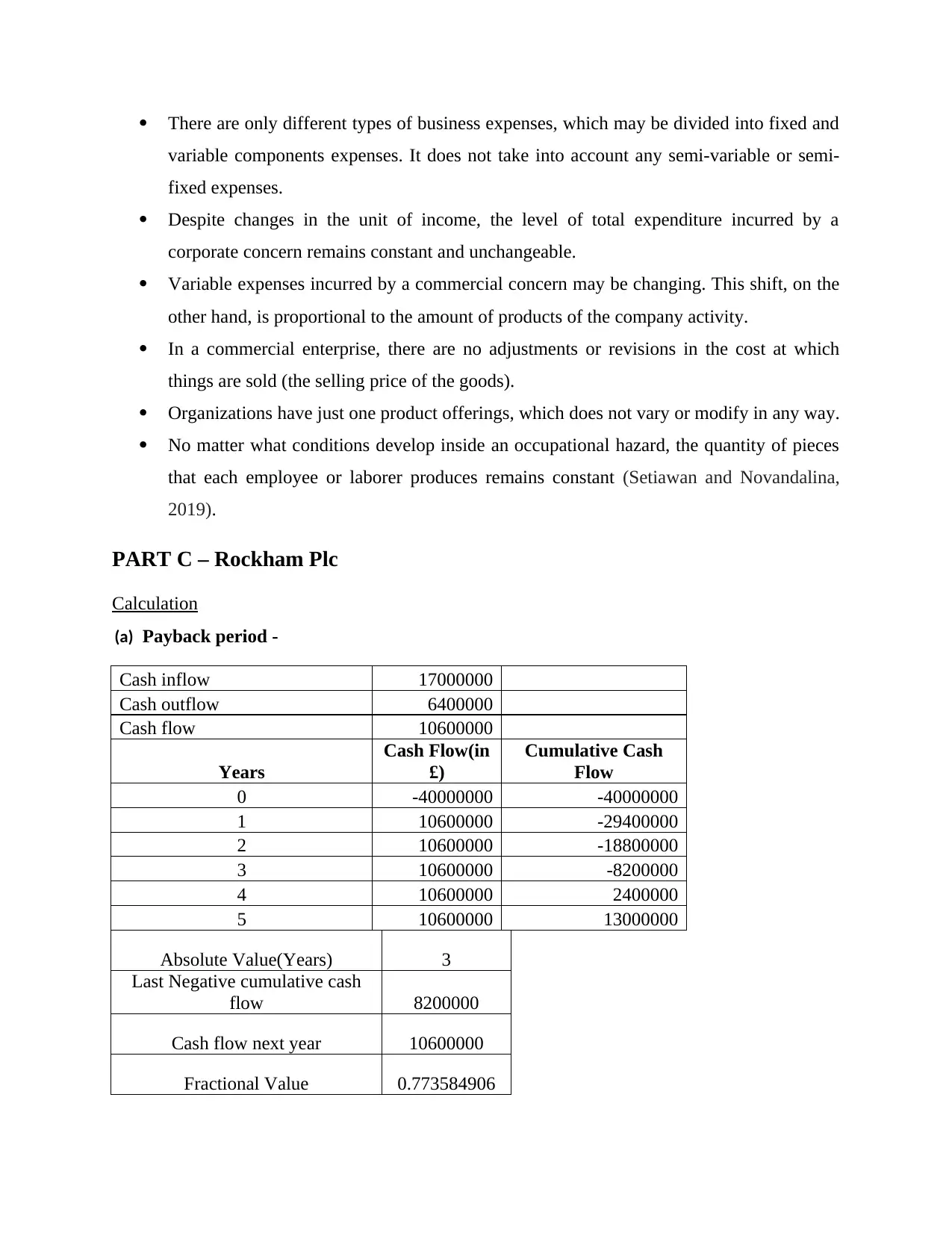
There are only different types of business expenses, which may be divided into fixed and
variable components expenses. It does not take into account any semi-variable or semi-
fixed expenses.
Despite changes in the unit of income, the level of total expenditure incurred by a
corporate concern remains constant and unchangeable.
Variable expenses incurred by a commercial concern may be changing. This shift, on the
other hand, is proportional to the amount of products of the company activity.
In a commercial enterprise, there are no adjustments or revisions in the cost at which
things are sold (the selling price of the goods).
Organizations have just one product offerings, which does not vary or modify in any way.
No matter what conditions develop inside an occupational hazard, the quantity of pieces
that each employee or laborer produces remains constant (Setiawan and Novandalina,
2019).
PART C – Rockham Plc
Calculation
(a) Payback period -
Cash inflow 17000000
Cash outflow 6400000
Cash flow 10600000
Years
Cash Flow(in
£)
Cumulative Cash
Flow
0 -40000000 -40000000
1 10600000 -29400000
2 10600000 -18800000
3 10600000 -8200000
4 10600000 2400000
5 10600000 13000000
Absolute Value(Years) 3
Last Negative cumulative cash
flow 8200000
Cash flow next year 10600000
Fractional Value 0.773584906
variable components expenses. It does not take into account any semi-variable or semi-
fixed expenses.
Despite changes in the unit of income, the level of total expenditure incurred by a
corporate concern remains constant and unchangeable.
Variable expenses incurred by a commercial concern may be changing. This shift, on the
other hand, is proportional to the amount of products of the company activity.
In a commercial enterprise, there are no adjustments or revisions in the cost at which
things are sold (the selling price of the goods).
Organizations have just one product offerings, which does not vary or modify in any way.
No matter what conditions develop inside an occupational hazard, the quantity of pieces
that each employee or laborer produces remains constant (Setiawan and Novandalina,
2019).
PART C – Rockham Plc
Calculation
(a) Payback period -
Cash inflow 17000000
Cash outflow 6400000
Cash flow 10600000
Years
Cash Flow(in
£)
Cumulative Cash
Flow
0 -40000000 -40000000
1 10600000 -29400000
2 10600000 -18800000
3 10600000 -8200000
4 10600000 2400000
5 10600000 13000000
Absolute Value(Years) 3
Last Negative cumulative cash
flow 8200000
Cash flow next year 10600000
Fractional Value 0.773584906
Paraphrase This Document
Need a fresh take? Get an instant paraphrase of this document with our AI Paraphraser
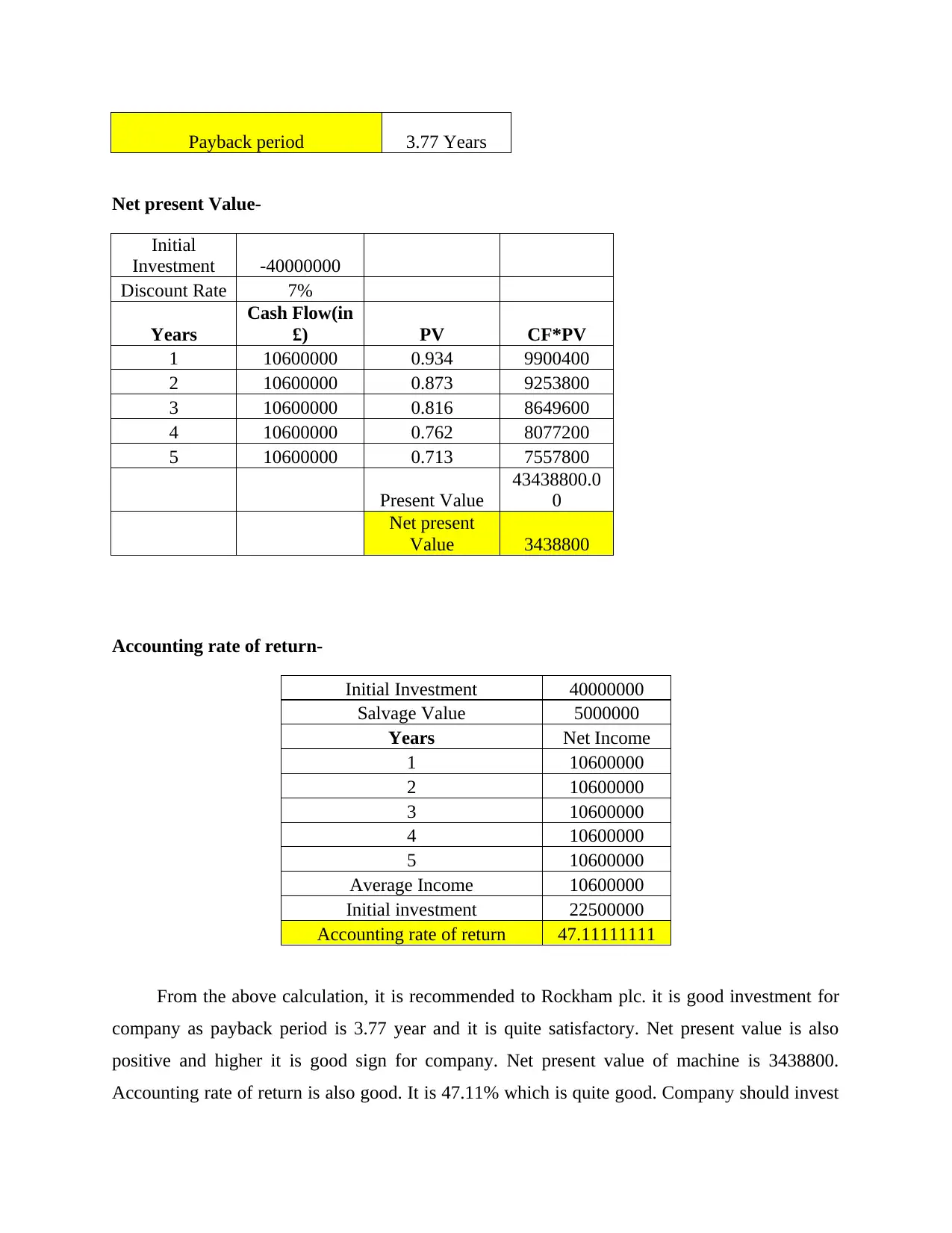
Payback period 3.77 Years
Net present Value-
Initial
Investment -40000000
Discount Rate 7%
Years
Cash Flow(in
£) PV CF*PV
1 10600000 0.934 9900400
2 10600000 0.873 9253800
3 10600000 0.816 8649600
4 10600000 0.762 8077200
5 10600000 0.713 7557800
Present Value
43438800.0
0
Net present
Value 3438800
Accounting rate of return-
Initial Investment 40000000
Salvage Value 5000000
Years Net Income
1 10600000
2 10600000
3 10600000
4 10600000
5 10600000
Average Income 10600000
Initial investment 22500000
Accounting rate of return 47.11111111
From the above calculation, it is recommended to Rockham plc. it is good investment for
company as payback period is 3.77 year and it is quite satisfactory. Net present value is also
positive and higher it is good sign for company. Net present value of machine is 3438800.
Accounting rate of return is also good. It is 47.11% which is quite good. Company should invest
Net present Value-
Initial
Investment -40000000
Discount Rate 7%
Years
Cash Flow(in
£) PV CF*PV
1 10600000 0.934 9900400
2 10600000 0.873 9253800
3 10600000 0.816 8649600
4 10600000 0.762 8077200
5 10600000 0.713 7557800
Present Value
43438800.0
0
Net present
Value 3438800
Accounting rate of return-
Initial Investment 40000000
Salvage Value 5000000
Years Net Income
1 10600000
2 10600000
3 10600000
4 10600000
5 10600000
Average Income 10600000
Initial investment 22500000
Accounting rate of return 47.11111111
From the above calculation, it is recommended to Rockham plc. it is good investment for
company as payback period is 3.77 year and it is quite satisfactory. Net present value is also
positive and higher it is good sign for company. Net present value of machine is 3438800.
Accounting rate of return is also good. It is 47.11% which is quite good. Company should invest
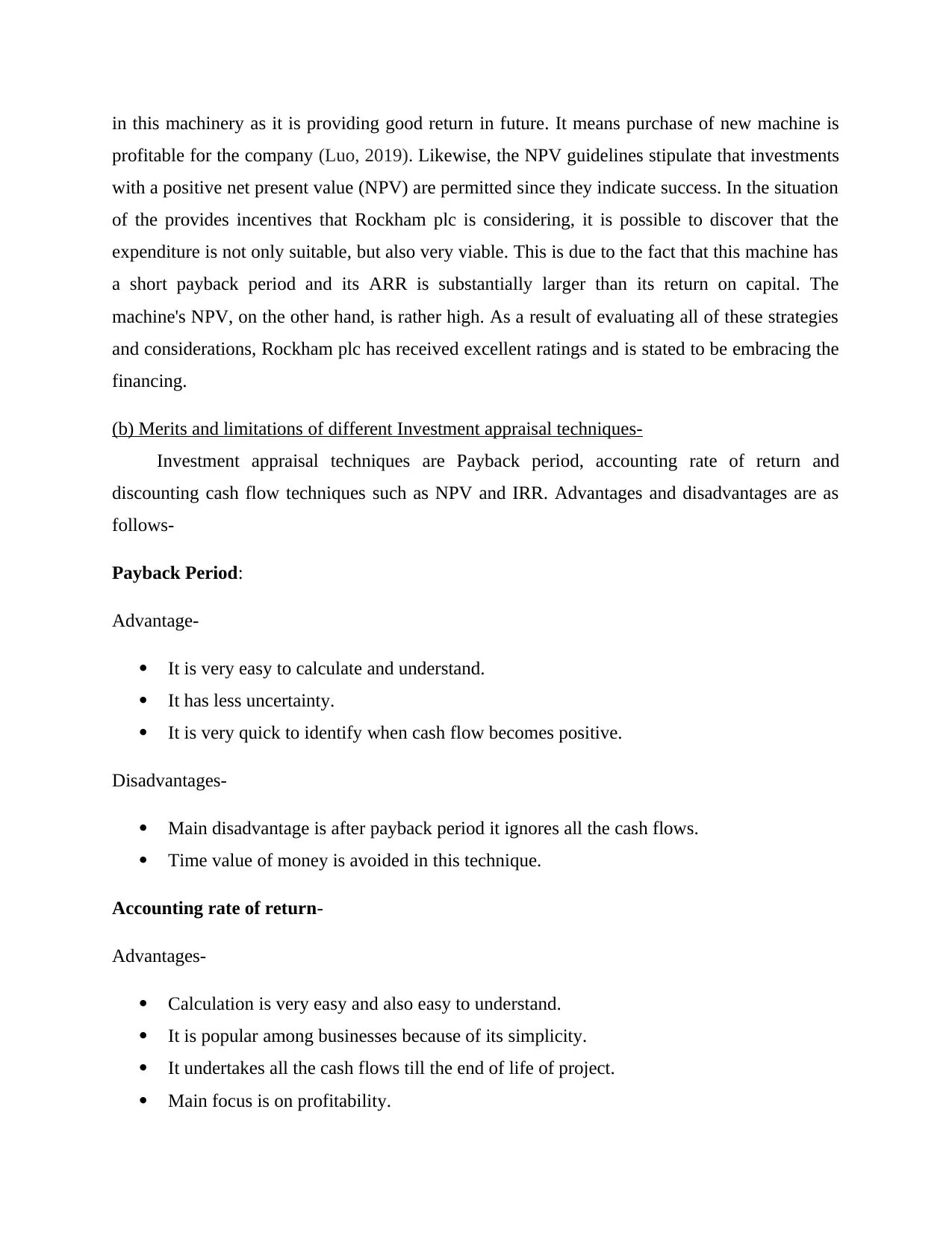
in this machinery as it is providing good return in future. It means purchase of new machine is
profitable for the company (Luo, 2019). Likewise, the NPV guidelines stipulate that investments
with a positive net present value (NPV) are permitted since they indicate success. In the situation
of the provides incentives that Rockham plc is considering, it is possible to discover that the
expenditure is not only suitable, but also very viable. This is due to the fact that this machine has
a short payback period and its ARR is substantially larger than its return on capital. The
machine's NPV, on the other hand, is rather high. As a result of evaluating all of these strategies
and considerations, Rockham plc has received excellent ratings and is stated to be embracing the
financing.
(b) Merits and limitations of different Investment appraisal techniques-
Investment appraisal techniques are Payback period, accounting rate of return and
discounting cash flow techniques such as NPV and IRR. Advantages and disadvantages are as
follows-
Payback Period:
Advantage-
It is very easy to calculate and understand.
It has less uncertainty.
It is very quick to identify when cash flow becomes positive.
Disadvantages-
Main disadvantage is after payback period it ignores all the cash flows.
Time value of money is avoided in this technique.
Accounting rate of return-
Advantages-
Calculation is very easy and also easy to understand.
It is popular among businesses because of its simplicity.
It undertakes all the cash flows till the end of life of project.
Main focus is on profitability.
profitable for the company (Luo, 2019). Likewise, the NPV guidelines stipulate that investments
with a positive net present value (NPV) are permitted since they indicate success. In the situation
of the provides incentives that Rockham plc is considering, it is possible to discover that the
expenditure is not only suitable, but also very viable. This is due to the fact that this machine has
a short payback period and its ARR is substantially larger than its return on capital. The
machine's NPV, on the other hand, is rather high. As a result of evaluating all of these strategies
and considerations, Rockham plc has received excellent ratings and is stated to be embracing the
financing.
(b) Merits and limitations of different Investment appraisal techniques-
Investment appraisal techniques are Payback period, accounting rate of return and
discounting cash flow techniques such as NPV and IRR. Advantages and disadvantages are as
follows-
Payback Period:
Advantage-
It is very easy to calculate and understand.
It has less uncertainty.
It is very quick to identify when cash flow becomes positive.
Disadvantages-
Main disadvantage is after payback period it ignores all the cash flows.
Time value of money is avoided in this technique.
Accounting rate of return-
Advantages-
Calculation is very easy and also easy to understand.
It is popular among businesses because of its simplicity.
It undertakes all the cash flows till the end of life of project.
Main focus is on profitability.
⊘ This is a preview!⊘
Do you want full access?
Subscribe today to unlock all pages.

Trusted by 1+ million students worldwide
1 out of 17
Related Documents
Your All-in-One AI-Powered Toolkit for Academic Success.
+13062052269
info@desklib.com
Available 24*7 on WhatsApp / Email
![[object Object]](/_next/static/media/star-bottom.7253800d.svg)
Unlock your academic potential
Copyright © 2020–2025 A2Z Services. All Rights Reserved. Developed and managed by ZUCOL.




